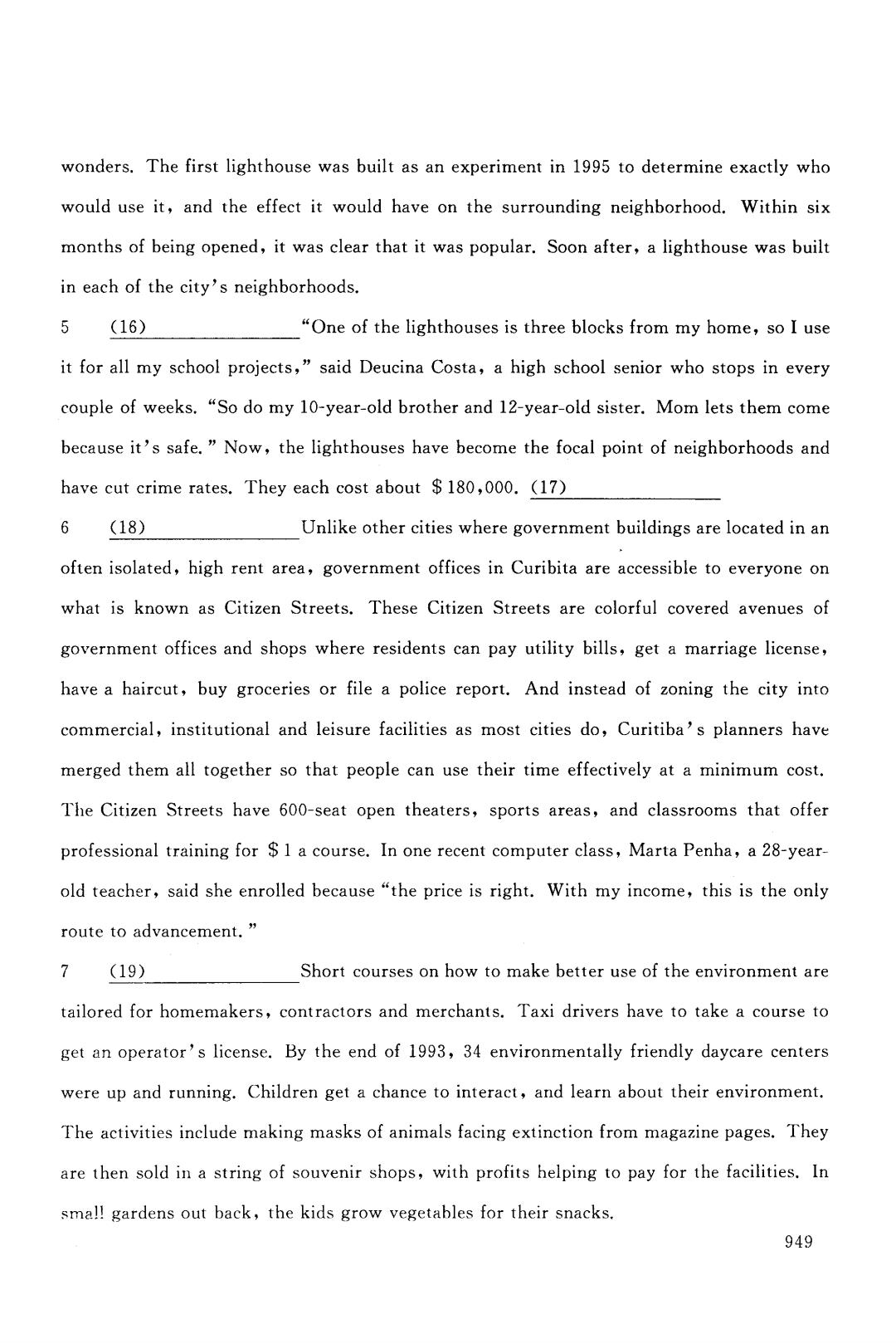正在加载图片...

wonders.The first lighthouse was built as an experiment in 1995 to determine exactly who would use it,and the effect it would have on the surrounding neighborhood.Within six months of being opened,it was clear that it was popular.Soon after,a lighthouse was built in each of the city's neighborhoods. 5 (16) "One of the lighthouses is three blocks from my home,so I use it for all my school projects,said Deucina Costa,a high school senior who stops in every couple of weeks."So do my 10-year-old brother and 12-year-old sister.Mom lets them come because it's safe."Now,the lighthouses have become the focal point of neighborhoods and have cut crime rates.They each cost about 180,000.(17) 6 (18) Unlike other cities where government buildings are located in an often isolated,high rent area,government offices in Curibita are accessible to everyone on what is known as Citizen Streets.These Citizen Streets are colorful covered avenues of government offices and shops where residents can pay utility bills,get a marriage license, have a haircut,buy groceries or file a police report.And instead of zoning the city into commercial,institutional and leisure facilities as most cities do,Curitiba's planners have merged them all together so that people can use their time effectively at a minimum cost. The Citizen Streets have 600-seat open theaters,sports areas,and classrooms that offer professional training for 1 a course.In one recent computer class,Marta Penha,a 28-year- old teacher,said she enrolled because "the price is right.With my income,this is the only route to advancement. 7 (19) Short courses on how to make better use of the environment are tailored for homemakers,contractors and merchants.Taxi drivers have to take a course to get an operator's license.By the end of 1993,34 environmentally friendly daycare centers were up and running.Children get a chance to interact,and learn about their environment. The activities include making masks of animals facing extinction from magazine pages.They are then sold in a string of souvenir shops,with profits helping to pay for the facilities.In small gardens out back,the kids grow vegetables for their snacks. 949wonders. The first lighthouse was built as an experiment in 1995 to determine exactly who would use it , and the effect it would have on the surrounding neighborhood. Within six months of being opened , it was clear that it was popular. Soon after, a lighthouse was built in each of the city's neighborhoods. 5 (1 6 ) "One of the lighthouses is three blocks from my home , so I use it for all my school projects," said Deucina Costa , a high school senior who stops in every couple of weeks. "So do my 10-year-old brother and 12-year-old sister. Mom lets them come because it's safe." Now , the lighthouses have become the focal point of neighborhoods and have cut crime rates. They each cost about $ 180 ,000. (1 7) 6 (1 8 ) Unlike other cities where government buildings are located in an often isolated , high rent area , government offices in Curibita are accessible to everyone on what is known as Citizen Streets. These Citizen Streets are colorful covered avenues of government offices and shops where residents can pay utility bills, get a marriage license , have a haircut , buy groceries or file a police 巳port. And instead of zoning the city into commercial , institutional and leisure facilities as most cities do , Curitiba' s planners have merged them all together so that people can use their time effectively at a minimum cost. The Citizen Streets have 600-seat open theaters, sports areas, and classrooms that offer professional training for $ 1 a course. In one recent computer class, Marta Penha , a 28-yearold teacher, said she enrolled because "the price is right. With my income , this is the only route to advancement. " 7 (1 9 ) Short courses on how to make better use of the environment are tailored for homemakers, contractors and merchants. Taxi drivers have to take a course to get an operator' s license. By the end of 1993 , 34 environmentally friendly daycare centers were up and running. Children get a chance to interact , and learn about their environment. The activities include making masks of animals facing extinction from magazine pages. They are then sold in a string of souvenir shops, with profits helping to pay for the facilities. In sma!! gardens out back , the kids grow vegetables for their snacks. 949